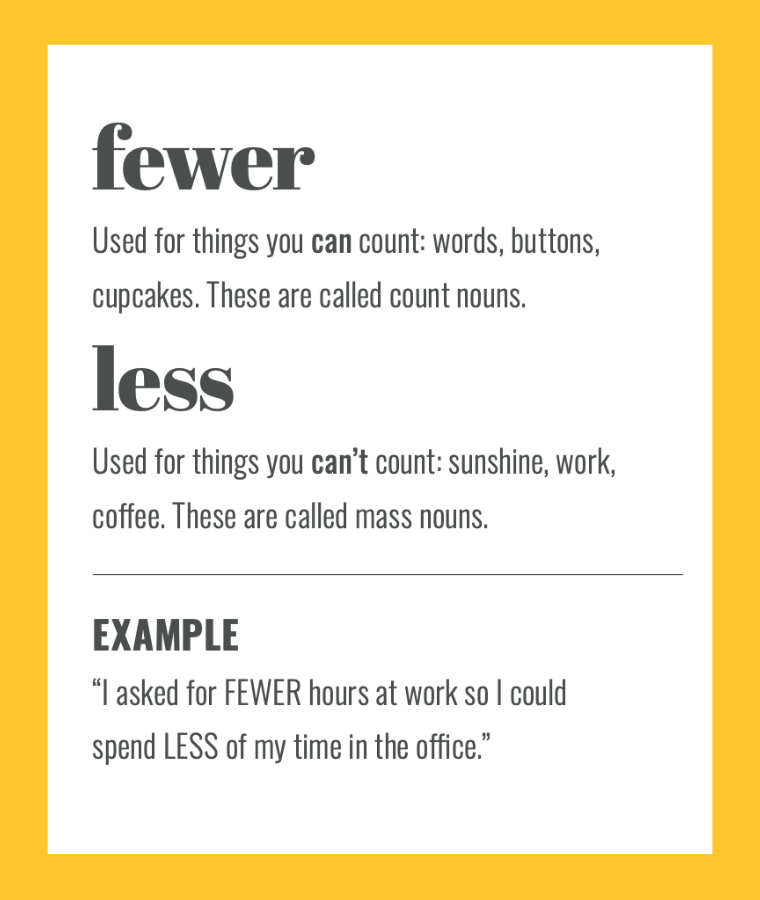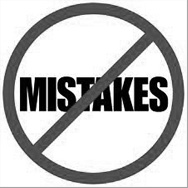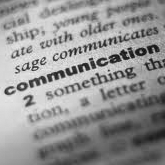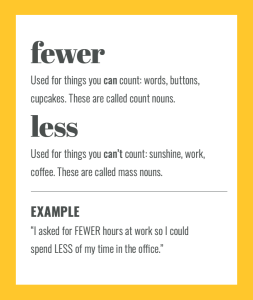Less vs fewer. A simple tip to get it right every time

There are two types of people – those who are irritated by supermarket Five items or less signs (Fewer! It should be FEWER!) and those who don’t know the difference. Do you know the super simple tip to tell them apart?
Use LESS for things you can’t count:
- less sunshine
- less work
- less coffee
Use FEWER for things you can count (like the items in your shopping basket):
- fewer words
- fewer buttons
- fewer cupcakes
So there you go. If you can count it, use FEWER. If you can’t, use LESS.
More tips = fewer mistakes + less confusion.
Bonus tip
Once you know that things you can count are called ‘count nouns’ and things you can’t count are called ‘mass nouns’ you can apply the same logic to MANY and MUCH.
Use MANY for things you can count, and MUCH for things you can’t.
For example:
- Using too many words can confuse your message.
- Too much confusion can prevent customers from choosing your business.
Get more tips in The Little Book of Confusables
Don’t get caught out by the apostrophe in time expressions

Wondering whether expressions such as ONE WEEK’S HOLIDAY and FIVE YEAR’S TIME need an apostrophe?
The answer is yes.
Here’s how to use an apostrophe in time expressions.
So, where does the pesky apostrophe go?
Easy. If the period of time is singular, the apostrophe goes before the s:
- One week’s notice
- One month’s holiday
- One year’s experience
If the period of time is plural, the apostrophe goes after the s:
- Two weeks’ notice
- Two months’ holiday
- Two years’ experience
Oh yuk – must I really?
Not everyone likes that tricksy little apostrophe, but now you know it’s earned its place you can’t leave it out for fear of looking silly, right?
But don’t worry.
If writing “I have 20 years’ experience” on your website or LinkedIn profile makes you pull a face, just replace the apostrophe with OF.
“I have 20 years of experience.”
Easy as that.
Why failing to proofread is losing you business

Whether you like it or not, mistakes in your marketing cost you customers and sales. Online errors can affect your search rankings, and sloppy spelling drives potential customers to question your credibility, and buy from your competitors, instead.
We’ve all seen examples of pitiful proofreading that make us cringe. How do you make sure your business isn’t next in line for the hall of shame?
We’re all under pressure – our inboxes are full of unanswered messages, our ‘to do’ lists get longer when they should be getting shorter, and there are never enough hours in the day… it’s no surprise we end up cutting corners.
You’re too close to your own work to proofread it yourself, and your colleagues are just as busy so there’s no point asking them for help.
Avoid the pitfalls of pitiful proofreading
Your marketing literature, website and social media accounts are often the first contact potential clients have with your business. You budget for design and print – even copywriting – yet how often have you risked your investment by skimping on proofreading… then found embarrassing typos in the finished product?
A 2013 study revealed that 59 per cent of UK consumers wouldn’t use a company that had obvious grammatical or spelling mistakes on its website or marketing material because they wouldn’t trust the company to provide good quality service. Others were put off due to an obvious lack of care, and considered the business to be unprofessional as a result of the mistakes.
Spellcheck schmellcheck
So you don’t have time to proofread but you’ve run a spellcheck so it’s okay, right? Wrong. Spellcheck doesn’t know if you’ve repeated a word, or left one out, neither does it know if you’ve used the right word – it only knows whether the words you’ve used are spelled incorrectly (that’s one C, two Rs).
Computers can’t check context: they don’t know if you meant there, their or they’re, affect or effect, loose or lose. And – oops! – you just spelt manager as manger. Sorry, it won’t spot that either. P45 anyone?
Each time you rely on spellcheck you risk mistakes and errors in your writing. Homophones – words that sound the same, but have different spellings and different meanings, like the examples below – are partly to blame:
- your, you’re
- to, too, two
- there, they’re, their
- sight, site
- board, bored
So, don’t sack your spellchecker, but don’t rely on it to do your job for you – it’s never a substitute for proofreading. Consider professional proofreading as security on your investment. It may be another expense, but it’ll pay for itself many times over.
As the saying goes, ‘There’s never time to do it right, but always time to do it again.’ Don’t learn the hard way.
10 bitesized tips for better business writing

Want to write clever copy and compelling content that gets your business noticed for all the right reasons?
Here are 10 bitesized tips to boost your business writing brilliance.
1 Get noticed
Attract attention by summarising the key points of your message upfront.
You can do this using a benefit-led headline, or an introductory paragraph that summarises the who, what, when, where, why and how of your message.
2 Keep it short
Your reader is overloaded with information – and your writing needs to cut through the communication chatter.
Keep it brief.
Use short, punchy sentences and paragraphs, and avoid filler words that add nothing.
3 Keep it simple
Communicate your message clearly using simple language and plain English.
Avoid business speak, buzzwords and jargon.
See my plain English cheat sheet.
4 Know your audience
It helps to have a good understanding of who you’re writing for, so get clear on your target client and their needs.
Think of your writing as a conversation with one individual – not a group of people – to create a connection with your reader.
5 Be more human
Business writing doesn’t need to be formal or stuffy. Remember: you’re a person communicating with another person.
Switch robotic business speak and jargon for human language – real words, real people really use.
6 WIIFM?
Focus your writing on the outcome for your audience – the “what’s in it for me?”.
Engage your readers by talking about benefits, not features (remember, Canon don’t sell cameras, they sell memories).
7 Include a call to action
Your communication should aim to inform, entertain or inspire action.
Be clear about your goal: what action do you want your reader to take as a result?
This could be signing up for email updates, buying a new product or attending an event.
8 Check, check and check again
Don’t undo your good work by spelling your boss’s name wrong, or including the wrong date for your event.
Check your language, spelling and punctuation.
Ask a colleague to read it over, or hire a professional proofreader. A fresh pair of eyes will spot things you’ve missed.
Never rely on your spellchecker as a substitute for proofreading.
9 Say it loud
Using your computer’s read-aloud feature will help you spot mistakes and repetition far more easily than reading on screen, or a printout.
I don’t know why this works – I just know it does.
Try it!
10 Sleep on it
If you have time in your schedule, review what you’ve written the following morning.
You’ll be surprised what you’ll spot when you reread your document with fresh eyes.
That’s it! 10 bitesized tips to boost your business writing brilliance.
Which is your favourite?


